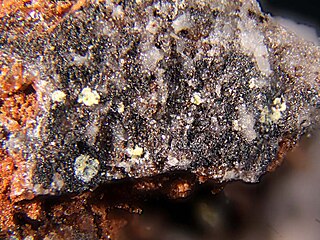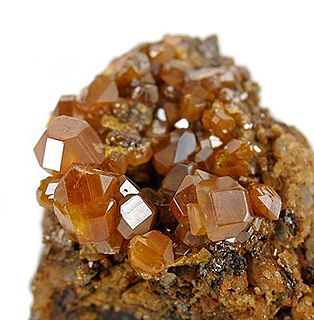 W
WAnthoinite is an aluminum tungsten oxide mineral with the chemical formula AlWO3(OH)3. Its type locality is Maniema in the Democratic Republic of the Congo.
 W
WFerberite is the iron endmember of the manganese - iron wolframite solid solution series. The manganese endmember is hübnerite. Ferberite is a black monoclinic mineral composed of iron(II) tungstate, FeWO4.
 W
WHübnerite or hubnerite is a mineral consisting of manganese tungsten oxide (chemical formula MnWO4). It is the manganese endmember of the manganese–iron wolframite solid solution series. It forms reddish brown to black monoclinic prismatic submetallic crystals. The crystals are typically flattened and occur with fine striations. It has a high specific gravity of 7.15 and a Mohs hardness of 4.5. It is transparent to translucent with perfect cleavage. Refractive index values are nα = 2.170 - 2.200, nβ = 2.220, and nγ = 2.300 - 2.320.
 W
WHydrokenoelsmoreite is a hydrous tungsten oxide mineral with formula □2W2O6(H2O). Hydrokenoelsmoreite is a colorless to white, translucent isometric mineral. It has a Mohs hardness of 3, exhibits no cleavage and has a splintery fracture. It has a vitreous to adamantine luster. It is optically isotropic with an index of refraction of n = 2.24.
 W
WKhomyakovite is an exceedingly rare mineral of the eudialyte group, with formula Na12Sr3Ca6Fe3Zr3WSi(Si9O27)2(Si3O9)2O(O,OH,H2O)3(OH,Cl)2. The original formula was extended to show the presence of both the cyclic silicate groups and M4-site silicon, according to the nomenclature of the eudialyte group. Some niobium substitutes for tungsten in khomyakovite. Khomyakovite is an iron-analogue of manganokhomyakovite, the second mineral being a bit more common. The two minerals are the only group representatives, beside taseqite, with species-defining strontium, although many other members display strontium diadochy. Khomyakovite is the third eudialyte-group mineral with essential tungsten (after johnsenite-(Ce) and manganokhomyakovite).
 W
WManganokhomyakovite is a very rare mineral of the eudialyte group, with formula Na12Sr3Ca6Mn3Zr3WSi(Si9O27)2(Si3O9)2O(O,OH,H2O)3(OH,Cl)2. This formula is in extended form (based on the original one), to show the presence of cyclic silicate groups and domination of silicon at the M4 site, basing on the nomenclature of the eudialyte group. Some niobium substitutes for tungsten in khomyakovite. As suggested by its name, manganokhomyakovite is a manganese-analogue of khomyakovite, the latter being more rare. The two minerals are the only group representatives, beside taseqite, with species-defining strontium, although many other members display strontium diadochy. Manganokhomyakovite is the third eudialyte-group mineral with essential tungsten (after johnsenite-(Ce) and khomyakovite).
 W
WRaspite is a mineral, a lead tungstate; with the formula PbWO4. It forms yellow to yellowish brown monoclinic crystals. It is the low temperature monoclinic dimorph of the tetragonal stolzite.
 W
WRussellite is a bismuth tungstate mineral with the chemical formula Bi2WO6. It crystallizes in the orthorhombic crystal system. Russellite is yellow or yellow-green in color, with a Mohs hardness of 3 1⁄2.
 W
WScheelite is a calcium tungstate mineral with the chemical formula CaWO4. It is an important ore of tungsten (wolfram). Well-formed crystals are sought by collectors and are occasionally fashioned into gemstones when suitably free of flaws. Scheelite has been synthesized using the Czochralski process; the material produced may be used to imitate diamond, as a scintillator, or as a solid-state lasing medium. It was also used in radium paint in the same fashion as was zinc sulphide, and Thomas Edison invented a fluoroscope with a calcium tungstate-coated screen, making the images six times brighter than those with barium platinocyanide; the latter chemical allowed Röntgen to discover X-rays in early November 1895.
 W
WStolzite is a mineral, a lead tungstate; with the formula PbWO4. It is similar to, and often associated with, wulfenite which is the same chemical formula except that the tungsten is replaced by molybdenum. Stolzite crystallizes in the tetragonal crystal system and is dimorphous with the monoclinic form raspite.
 W
WTungsten, or wolfram, is a chemical element with the symbol W and atomic number 74. The name tungsten comes from the former Swedish name for the tungstate mineral scheelite, tungsten which means "heavy stone". Tungsten is a rare metal found naturally on Earth almost exclusively combined with other elements in chemical compounds rather than alone. It was identified as a new element in 1781 and first isolated as a metal in 1783. Its important ores include wolframite and scheelite.
 W
WTungstite is a hydrous tungsten oxide mineral with formula: WO3·H2O. It is a secondary mineral formed by the weathering of other tungsten containing minerals. It crystallizes in the orthorhombic system in translucent yellow to yellow green masses. It is clay-like with Mohs hardness of 2.5 and a specific gravity of 5.5.
 W
WWolframite, (Fe,Mn)WO4, is an iron manganese tungstate mineral that is the intermediate between ferberite (Fe2+ rich) and hübnerite (Mn2+ rich). Along with scheelite, the wolframite series are the most important tungsten ore minerals. Wolframite is found in quartz veins and pegmatites associated with granitic intrusives. Associated minerals include cassiterite, scheelite, bismuth, quartz, pyrite, galena, sphalerite, and arsenopyrite.